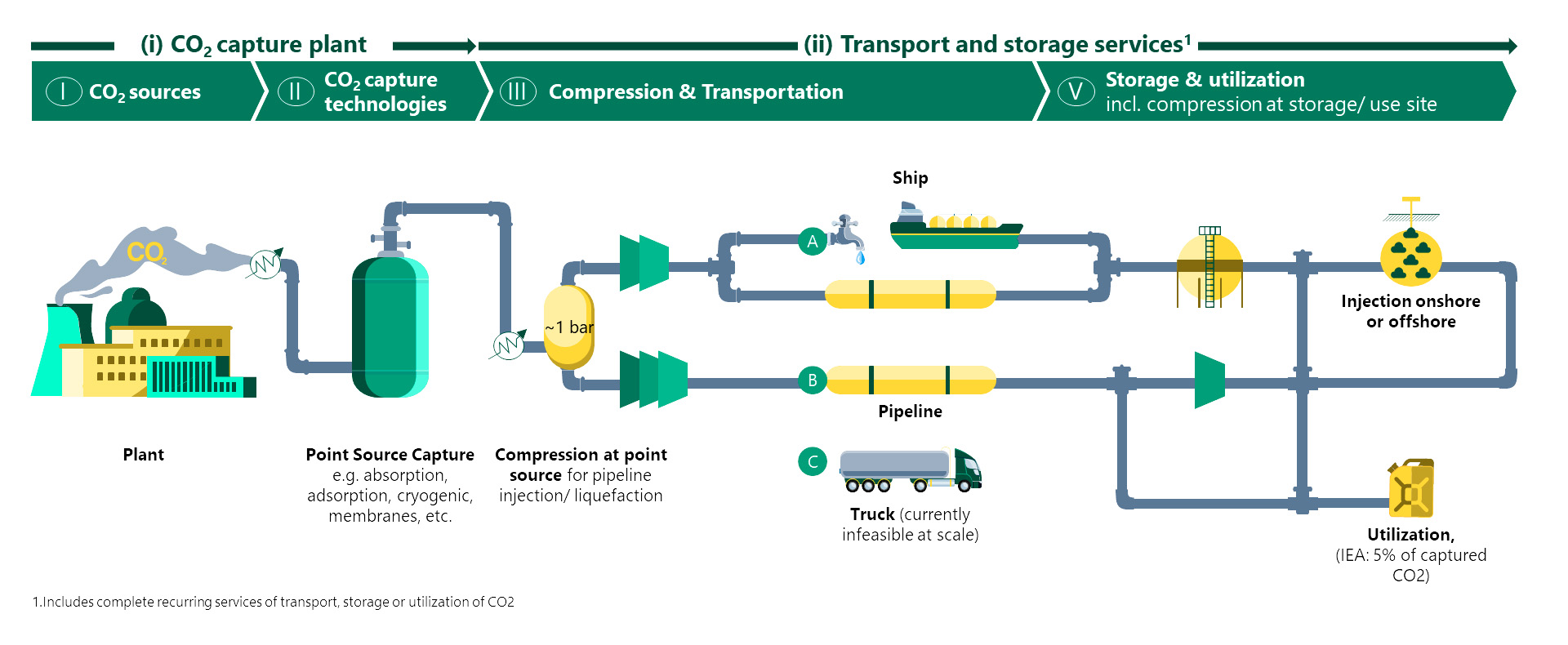Carbon Management
Carbon Capture, Utilization, and Storage (CCUS) is a necessary technology to reduce greenhouse gas emissions.
What is Carbon Capture?
Carbon Capture, Utilization, and Storage (CCUS) is a necessary technology to reduce greenhouse gas emissions and mitigate the impact of human activities in the climate. Industrial processes are responsible for approximately one-third of global carbon dioxide emissions, and CCUS applied to industrial processes is a critical solution to reduce them. The technology involves capturing carbon dioxide from industrial emissions, liquefying it, transporting it, and either using it (CCU) or storing it (CCS) underground, preventing it from being released into the atmosphere.
So how does it work?
The CCUS value chain consists of three primary components: capture, transportation, and uitilization & storage.
In the capture stage, carbon dioxide is separated from other gases that exist in industrial emissions, such as nitrogen and water vapor, using technologies like absorption or adsorption. After capture, the carbon dioxide must be transported to storage locations.
Transportation can occur through pipelines, where available, or via ships or trucks.
Finally, the carbon dioxide is stored in geological formations, such as depleted oil and gas reservoirs or deep saline formations, where it can be permanently stored and prevented from being released into the atmosphere.
Alternatively, it can be utilized in final applications, such as feedstock for greenhouses.

Why is Carbon Capture critical in the industrial sector?
There are industries for which decarbonization alternatives (such as electrification, or a switch to non-fossil fuels) are not expected to be technologically available or cost competitive in the medium term, at least not at a scale to allow for full decarbonization. Some of these “hard to abate” industries are cement, steel, and chemicals, where historically fossil fuels have been used to achieve the high temperatures required for the production processes. In addition, some of these industrial processes, such as cement production, involve a chemical reaction that produces carbon dioxide as a byproduct, and switching away from fossil fuels would not fully resolve the problem.
These industries are critical to modern society, providing essential materials for infrastructure, transportation, food, and multiple other goods our society needs. Carbon capture provides a way for these industries to reduce their emissions while continuing to operate, enabling a pathway towards decarbonization. Without carbon capture, these “hard to abate” industries could face a significant challenge in achieving global carbon emissions reductions targets.
Why does regulation matter?
There are currently several policies around the world providing a regulatory framework to incentivize carbon dioxide emissions reductions, including in the EU and USA.
The EU Emissions Trading System (EU-ETS) is a cap-and-trade system that applies to over 11,000 installations in the European Union. The system sets a cap on carbon emissions, and companies must hold allowances for their emissions. The number of allowances is reduced progressively to encourage emissions reductions.
In USA, on the other hand, the 45Q tax credit, part of the US Internal Revenue Code, provides a tax credit to companies for capturing and storing carbon dioxide emissions. The tax credit is available for carbon capture facilities that begin construction before 2026 and offers a credit of up to $85 per ton of carbon dioxide stored. A credit of $60 per ton is availably for the use of the captured carbon dioxide in enhanced oil recovery activities.

What do we propose?
track offers Carbon Capture as a Service (CCaaS), a turn-key solution that provides end-to-end carbon capture and storage services to help our clients achieve their carbon reduction goals. Our team of experts will design and build carbon capture plants in our clients’ facilities, operate and maintain them, and manage the transport and storage of the carbon dioxide on our clients’ behalf. Our solution is designed to be seamless, allowing our clients to focus on their core business activities while we take care of the rest.
With our CCaaS solution, clients can reduce their carbon footprint and meet their sustainability goals without the need for significant upfront capital investment in carbon capture infrastructure.
We adapt to our clients’ requirements and can tailor our offering to provide only the specific services our clients want (for example, providing only the design and construction of the capture plant). Our team is committed to safety and compliance, ensuring that all facilities meet regulatory requirements and operate at the highest standards.
